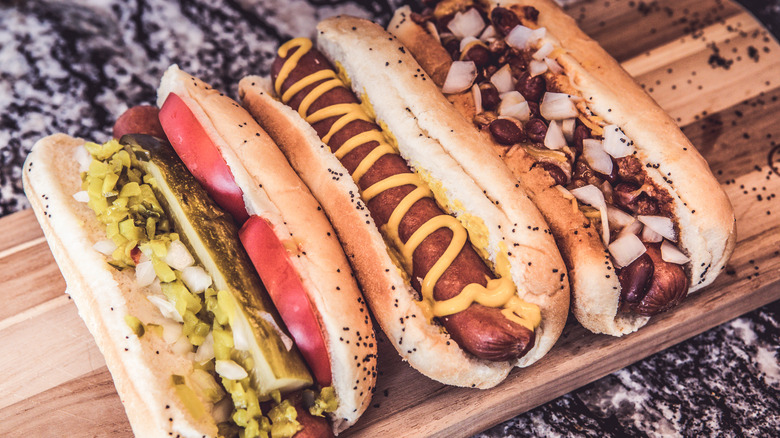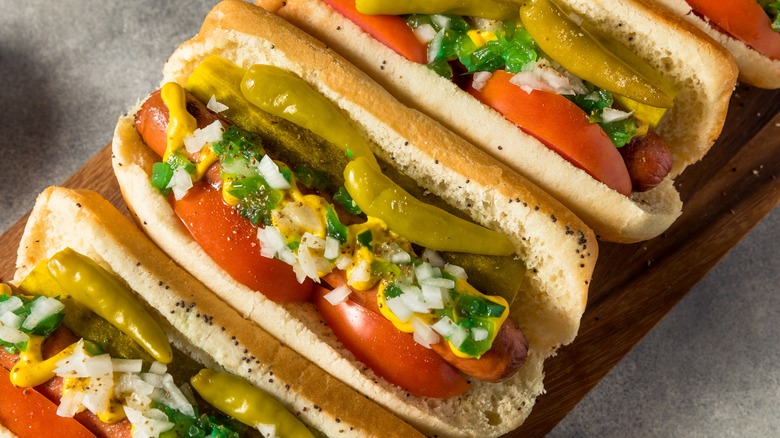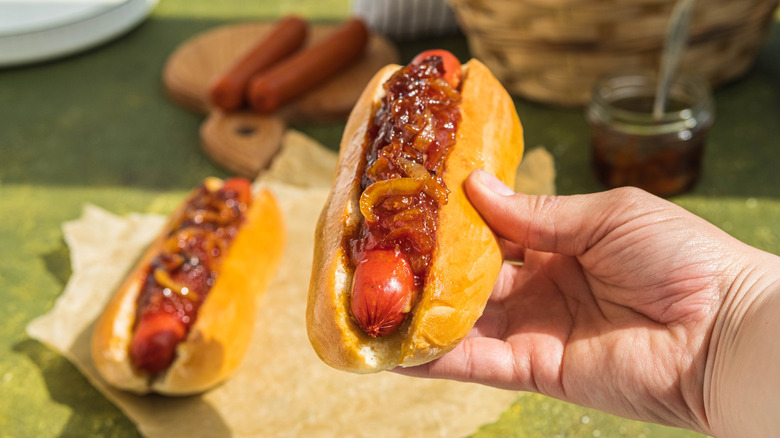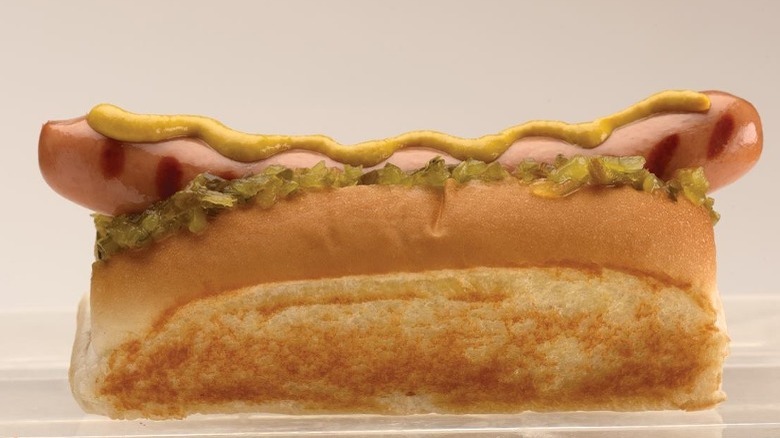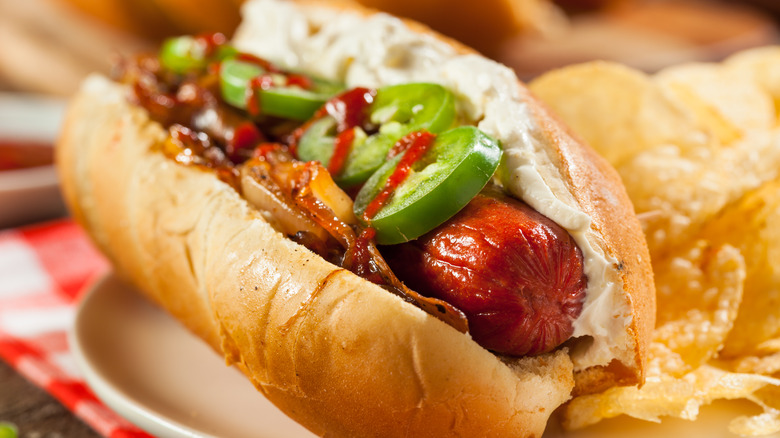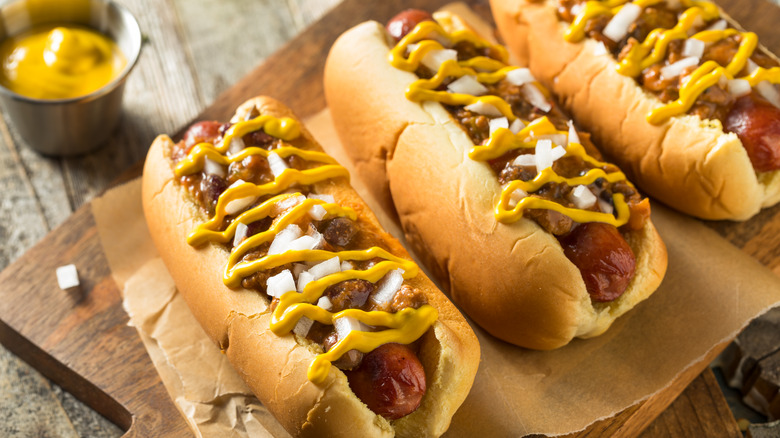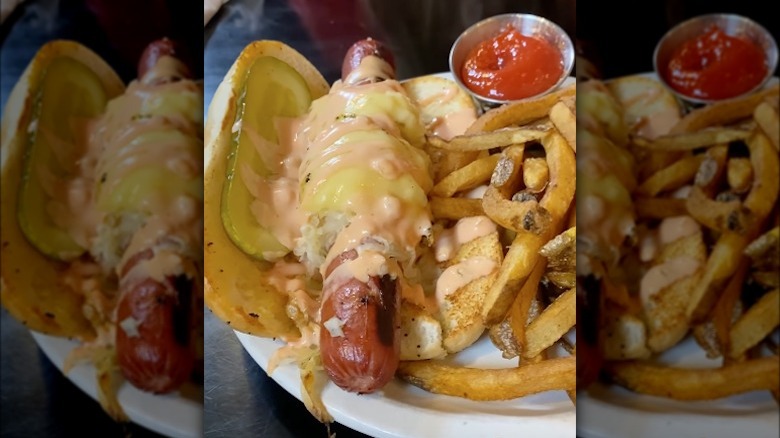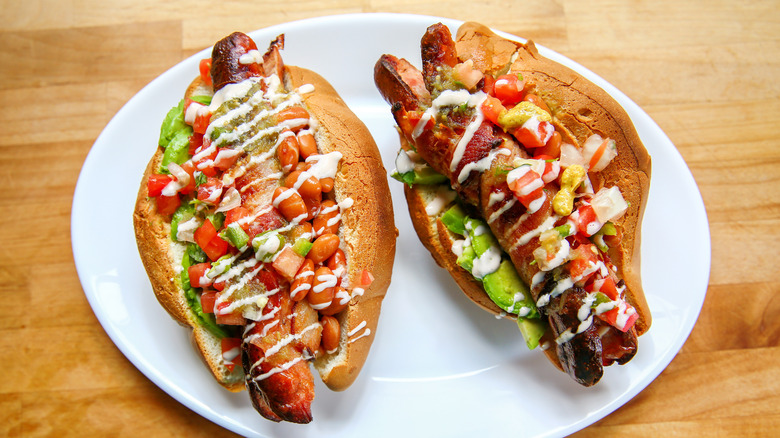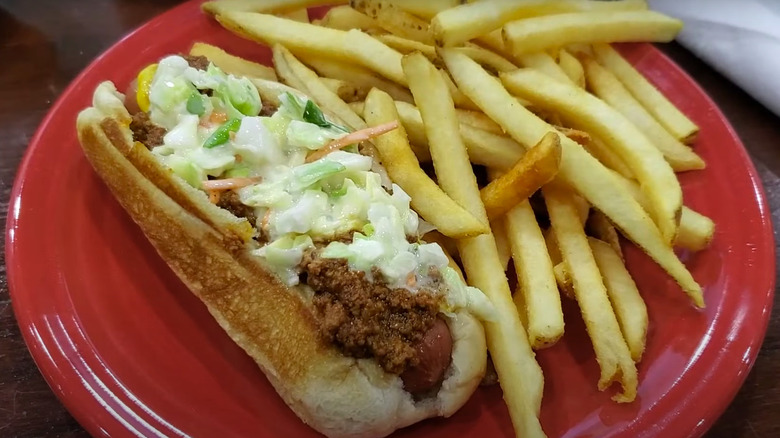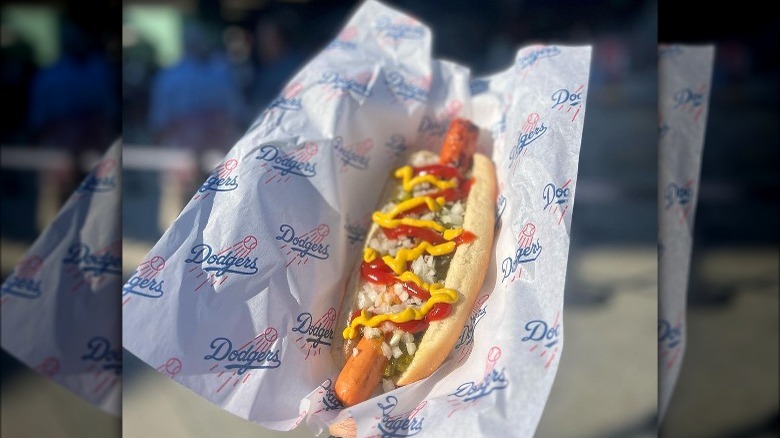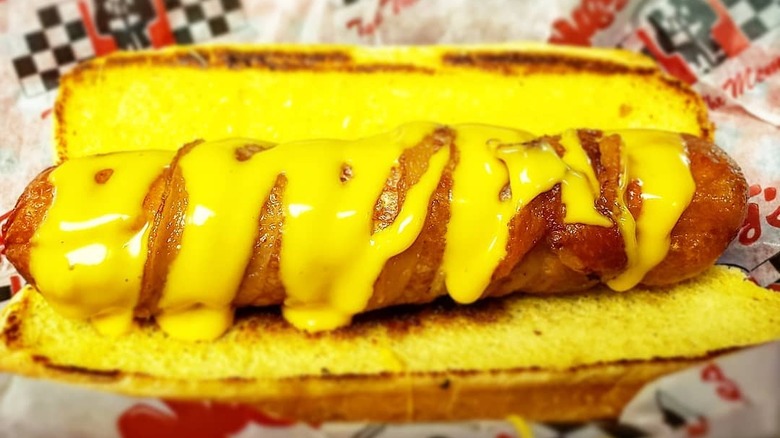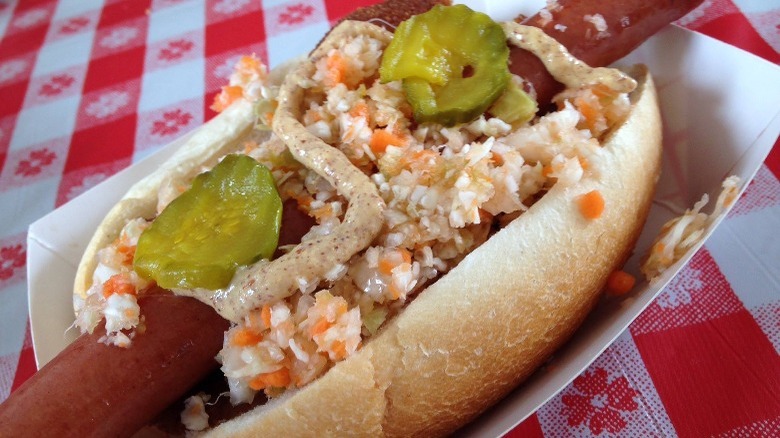13 US Hot Dog Styles You Need To Know About
Defining a quintessentially American food is a task rife with potential contention. The burger and fries often spring to mind as archetypal American fare. The humble hot dog, however, is another strong contender that has surely earned its place in the pantheon of classic American cuisine. Yet, mentioning hot dogs in any part of the country will inevitably spark passionate debates about what constitutes the perfect rendition of this iconic dish.
If you were to ask a Chicagoan about their ideal hot dog, their answer would likely feature a poppy-seed bun, all-beef sausage, and a colorful array of toppings known colloquially as being dragged through the garden. But pose the same question to someone living in the Hawaiian islands, and they might describe the unique Puka Dog, with its innovative hollowed-out bun and tropical fruit relishes. And, of course, the perennial question remains: is a hot dog technically a sandwich? We could dedicate an entire book to this discussion, but for now, we'll leave that to the culinary philosophers.
Yet, the inherent draw of the hot dog, and indeed, American food in general, lies not in its uniformity but in its variety. The diverse, regional interpretations of this seemingly simple dish reflect the nature of American culture itself. Each unique style of hot dog represents a different story, community, and slice of America. This incredible diversity, with its fascinating local twists and turns, perhaps makes the hot dog so quintessentially American.
Chicago Style Hot Dog
Finding yourself amidst the urban sprawl of Chicago, with your stomach growling and taste buds yearning for a flavorful delight, we strongly recommend you to seek out a quintessential local delicacy: the Chicago-style hot dog. This culinary gem can be found permeating every corner of the Windy City, from the comfortable seating of established restaurants to the convenience of bustling food trucks. Moreover, countless hot dog carts are strategically scattered around the city, serving these iconic dogs that are generously loaded with a variety of garden-fresh toppings. They provided a practical solution during the trying times of the Great Depression, offering a well-rounded, affordable meal conveniently packed onto a bun.
The construction of a Chicago-style hot dog is an art in itself. It begins with a warm, steamed bun, cradling a juicy, steamed hot dog. The hot dog is then meticulously adorned with a flavorful medley of ingredients. First comes the tangy mustard and vibrant neon relish, followed by finely chopped onions, adding a crunch and bite. The pickle spear lends a refreshing tang, while a dash of sports peppers introduces a gentle heat. Balanced by the fresh slices of tomatoes and finished off with a sprinkle of celery salt, this hot dog is a symphony of textures and flavors. Observant diners might notice a conspicuous absence – there is no ketchup. This is not a forgetful mishap but a deliberate omission, reflecting a treasured tradition in the creation of the authentic Chicago-style hot dog.
New York Hot Dog
Although both the Chicago-style and New York-style hot dogs share a common foundation, their cooking process, and toppings starkly differ, highlighting the diverse regional twists to this beloved classic. In contrast to the steaming method employed for the Chicago dogs, New York-style hot dogs are typically boiled, often right at the food carts dotting the bustling streets of New York, adding to their unique appeal.
New York hot dogs are characterized by their distinctive toppings. You'll frequently find them adorned with tangy onion and tomato sauce and sometimes a generous helping of sauerkraut or embellished with brown mustard paired harmoniously with sweet onion relish and tart sauerkraut. These unique combinations of flavors not only satiate the palates of New Yorkers but also serve as an enticing invitation to every visitor to the Big Apple.
Given the scale at which New Yorkers consume hot dogs, one might speculate that these particular toppings offer a certain gastronomic allure that is hard to resist. It could be the extraordinary fusion of flavors – the tang, the sweetness, the tartness – that truly encapsulate the cultural melting pot that New York City represents, appealing to both locals and tourists alike.
Fenway Frank
With the myriad of special, regional hot dogs across the country, much of the thrill indeed comes from the unique assortment of toppings, or how the hot dog is dressed. Yet, the Fenway Frank, hailing from Boston, stands out not for its attire but primarily for its exceptional cooking method. This beloved regional variation undergoes a two-step cooking process; it's first boiled, then delicately grilled. While most hot dogs are either steamed, boiled, or grilled, the Fenway Frank enjoys the best of two cooking methods, making it a truly special delicacy.
Kayem Foods is the current supplier of this hot dog, and while these dogs are delicious, what further sets this hot dog apart is the New England-style hot dog bun it is served on. These buns are incredibly soft, with a distinct buttery flavor, and are known to cradle not just the Fenway Frank but also another New England classic, the lobster roll, in their tender embrace.
Unlike the strictly defined toppings of the Chicago-style or the New York-style hot dogs, dressing a Fenway Frank is up to you and your own personal tastes. The choice of condiments is left to the discretion of the consumer. However, we highly recommend a hearty smear of mustard, which beautifully complements the unique flavor profile of the Fenway Frank, completing this Bostonian culinary rite of passage.
Seattle-Style Hot Dog
When it comes to regional hot dogs, the Seattle-style hot dog holds a unique spot, primarily due to its innovative creation by Hadley Long. Originally a vegetarian selling bagels with all meat-free toppings, Long found himself frequently fielding requests for meat additions. Deciding to pivot and address this demand, he ingeniously utilized a bialy-style hot dog bun, introduced by Dale Jones. These buns were made from the same dough as a bagel, but instead of being boiled, as traditional bagels are, they were baked, creating a delightful difference in texture and flavor.
The Seattle-style hot dog's uniqueness is further amplified by a signature twist: A generous layer of cream cheese slathered on the inside of the bun, pairing beautifully with the hot dog nestled within. This delectable combination evokes a bagel-like experience, effortlessly melding Long's vegetarian beginnings with his meaty innovation.
From there, the topping choices for this Pacific Northwestern specialty are as diverse as the city's cultural tapestry. While some favor spicy slices of jalapenos, others lean towards the classic tang of brown mustard.
Michigan Style Hot Dogs
Interestingly, the Michigan style hot dog, despite its name, is not a staple of Michigan's culinary scene. Instead, it is a specialty savored in Plattsburgh, New York, a charming town located not too far from Montreal. It's easy to mistakenly associate the Michigan-style hot dog with the well-known Coney Dog due to the confusing nomenclature, but they are indeed distinct entities.
The widely held belief is that the Michigan hot dog owes its name to a woman from Detroit who transported her meat sauce recipe to Plattsburgh. After all, the defining feature of a Michigan hot dog is a flavorful meat sauce lavished over the hot dog. Additional toppings like mustard and onions can be added as per the diner's preference.
The art of ordering a Michigan hot dog is subject to unique terminology. For a hot dog layered with mustard and onions underneath the meat sauce, you'd order it buried. To request a hot dog simply garnished with meat sauce, order it without. And if you fancy your onions and mustard sitting atop the meat sauce on the bun, you'd order it with. The layering of these toppings and their interplay with the hot dog beneath inevitably alter the flavor experience, offering a unique gastronomic journey with each variation.
Kansas-Style Hot Dogs
The quest to define a Kansas-style hot dog is rather intriguing as there doesn't seem to be a definitive, universally acknowledged hot dog devoted to the city. Some might suggest the popular hot dog available at Kauffman Stadium as the city's official representation, but this particular hot dog is a Reuben Dog, which may not capture the quintessential flavors of Kansas City.
The Reuben Dog, adorned with Swiss cheese, caraway seeds, sauerkraut, and Thousand Island dressing, is undoubtedly a delectable treat. However, it doesn't necessarily encapsulate the culinary identity of the city, even though it's widely recognized within Kansas City's gastronomic circles.
Others propose a more representative contender for the Kansas-style hot dog would be one that honors the city's renowned barbecue tradition. A hot dog topped with succulent, smoky brisket burnt ends, slathered in a classic Kansas City-style barbecue sauce, seems to resonate more closely with the city's food culture. Nevertheless, despite the plausible appeal of a barbecue-inspired hot dog, the Reuben dog continues to be the hot dog most closely associated with Kansas City.
Sonoran Dogs
The Sonoran hot dog, a culinary marvel bursting with diverse flavors, hails from the sunny landscapes of Tucson and Phoenix, Arizona. It's a gastronomic delight that holds its own against the vibrantly topped Chicago-style hot dog, often even giving it a run for its money due to its hefty assortment of ingredients.
The assembly of a Sonoran hot dog begins with the hot dog being snugly wrapped in bacon, introducing a smoky depth to its flavor. Once cooked, it's adorned with a myriad of toppings that take this humble hot dog to another level. Rich Pinto beans, fresh tomatoes, tangy relish, and onions grilled with peppers all join the party. To further amp up the flavor, a hearty serving of salsa, cheese, mayo, and mustard is added, making this hot dog a truly loaded indulgence.
Venture a little further south to Sonora, Mexico, and you'll discover variations of the Sonoran hot dog with even more local flavors. It may be topped with creamy Mexican crema and even guacamole or pico de gallo.
West Virginia-Style Hot Dogs
The West Virginia-style hot dog takes the notion of a chili dog and gives it a delightful twist, making it a cherished local favorite. One of the main differences lies in the chili itself, which is more aptly described as a meat sauce in this context. This sauce bears resemblance to conventional chili, but with notable exceptions: it omits beans and veggies, focusing instead on a blend of beef, apple cider vinegar, chili powder, ketchup, and an array of other spices, resulting in a robust, tangy flavor profile.
The meat sauce, however, is just the beginning of the West Virginia hot dog's charm. Atop the meat sauce, a generous layer of coleslaw is added, introducing a refreshing, crunchy contrast. The inclusion of mustard, a staple hot dog condiment, is a given, but with an added regional flair. In certain locales, you might find a specialty mustard, such as a zesty curry variant, which offers a unique, spiced undertone. To round off this flavor medley, a sprinkling of crunchy onions is added, providing the perfect finishing touch.
Detroit Coney Hot Dog
The Coney Hot Dog, hailing from Detroit, is a beloved variation of the classic chili dog. While similar in many respects, it shuns the traditional cheese topping often found on chili dogs and instead sports a layer of yellow mustard. Crisp, crunchy onions complete the assembly, delivering a textural contrast to the softness of the chili and the hot dog.
While the composition of the Coney Dog is quite straightforward, the charm and excitement surrounding this delicacy comes from where you choose to enjoy it. Two of Detroit's most popular establishments for a Coney Dog are Lafayette and American. These two iconic venues offer similar hot dogs, but with distinct takes on the key ingredient – the chili.
American Coney Island boasts a spicier chili sauce, sure to thrill those who love a bit of heat in their meal. In contrast, Lafayette Coney Island takes a different route, offering a chili sauce that is characterized by a more pronounced, rich beefy flavor. These subtle differences in their chili sauces set the two establishments apart, providing unique dining experiences, both centered around the cherished Detroit Coney Dog.
Dodger Dog
The uniqueness of the Dodger Dog, a staple at Dodger Stadium in Los Angeles, doesn't hinge on a diverse range of condiments or a specific cooking method. Instead, its specialty is derived from its impressive size. Unlike a typical hot dog that fits snugly within its bun, the Dodger Dog extends beyond the bun's boundaries, creating a distinctive and memorable eating experience.
As for the cooking process, there's an interesting bit of history worth mentioning. During the 1990s, concession stands experimented with boiling the Dodger Dogs. However, this shift from the traditional grilling method was met with considerable disapproval from fans. The outcry was so fervent that the decision was swiftly reversed, and the Dodger Dogs returned to their familiar grilled preparation method. In the end, this dog's popularity has everything to do with nostalgia and the sheer right of passage of enjoying a hot dog at a ballpark.
Hawaiian Hot Dogs
The Hawaiian culinary scene is a vibrant fusion of flavors, with one standout being the unique Hawaiian puka Dog, a native version of the hot dog that's a culinary experience unto itself and available at the aptly named puka Dog. The term puka in Hawaiian refers to a hole, and this is the feature that gives the puka dog its distinctive look and name. In essence, it's more akin to a stuffed corn dog than a typical hot dog you'd find elsewhere.
The magic of the puka dog begins with a freshly baked roll. A hole is created in the center of this roll using a rod that also toasts the interior of the bun, resulting in an intriguing contrast of textures with a crispy inside and soft outside. Then, the hollowed-out roll is filled with layers of unique, flavorful sauces. There's a lemon garlic sauce that comes in several varieties of heat levels, providing a tangy and spicy kick. To complement this, you have the option of choosing a tropical relish made from local fruits like mango and papaya, or even banana or star fruit. These fruit relishes add a sweet and tangy flavor that balances the spiciness of the garlic sauce.
The crowning glory of the puka dog is a generous drizzle of a special passion fruit mustard. This tropical-inspired condiment rounds off the flavor profile of the puka dog, bringing an explosion of sweet, tangy, and spicy flavors with every bite.
Texas Tommy Hot Dog
Contrary to its name, the Texas Tommy hot dog doesn't trace its roots back to the Lone Star State, but rather to Pottsville, Pennsylvania. You can find it at Nifty Fifty's throughout Pennsylvania. Like the Sonoran Dog, this particular hot dog creation brings a delightful twist to the traditional hot dog by being wrapped in bacon, offering a smoky and savory flavor that's hard to resist.
The Texas Tommy doesn't stop there. It's further adorned with a generous layer of melted American cheese or Cheese Wiz, infusing the hot dog with a creamy richness. As for the condiments, it keeps things classic with ketchup and mustard, offering a balance of sweet, tangy, and spicy flavors as well as a pop of color. For a Twist on this unique hot dog, you can also get it hitched, with macaroni and cheese on top. It's hard to imagine any child passing that customization up.
The origins of the Texas Tommy are somewhat ambiguous and are the subject of some debate. It's generally believed that it may date back to the 1940s, making it a long-standing staple in the regional hot dog scene.
Fish Cake Dog
Known by various names such as the combo or the poor man's surf and turf, this fish cake dog offers a delightful twist on the traditional hot dog. The combination of a classic hot dog with a deep-fried fish cake served on a bun creates a diverse mix of flavors, blending the land and sea in one scrumptious bite.
Adding to the complexity of the taste, this combo can be garnished with a variety of condiments according to personal preference. However, the must-have topping that sets this hot dog apart is the Pepper Hash. Pepper Hash is a vibrant, crunchy relish that's akin to a vinegar slaw, composed of finely shredded cabbage and carrots. The dish gets its name from the addition of sweet red bell peppers, which lend a splash of color and an added layer of sweetness to counterbalance the tanginess of the vinegar. The resulting combination is an enticing blend of flavors and textures – the savoriness of the hot dog, the crispness of the fish cake, and the sweet, tangy crunch of the Pepper Hash.
